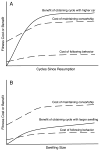Exaggerated sexual swellings and male mate choice in primates: testing the reliable indicator hypothesis in the Amboseli baboons
- PMID: 26752790
- PMCID: PMC4704114
- DOI: 10.1016/j.anbehav.2015.03.019
Exaggerated sexual swellings and male mate choice in primates: testing the reliable indicator hypothesis in the Amboseli baboons
Abstract
The paradigm of competitive males vying to influence female mate choice has been repeatedly upheld, but, increasingly, studies also report competitive females and choosy males. One female trait that is commonly proposed to influence male mate choice is the exaggerated sexual swelling displayed by females of many Old World primate species. The reliable indicator hypothesis posits that females use the exaggerated swellings to compete for access to mates, and that the swellings advertise variation in female fitness. We tested the two main predictions of this hypothesis in a wild population of baboons (Papio cynocephalus). First, we examined the effect of swelling size on the probability of mate-guarding ('consortship') by the highest-ranking male and the behavior of those males that trailed consorshipts ('follower males'). Second, we asked whether a female's swelling size predicted several fitness measures. We found that high-ranking males do not prefer females with larger swellings (when controlling for cycle number and conception) and that females with larger swellings did not have higher reproductive success. Our study-the only complete test of the reliable indicator hypothesis in a primate population-rejects the idea that female baboons compete for mates by advertising heritable fitness differences. Furthermore, we found unambiguous evidence that males biased their mating decisions in favor of females who had experienced more sexual cycles since their most recent pregnancy. Thus, rather than tracking the potential differences in fitness between females, male baboons appear to track and target the potential for a given reproductive opportunity to result in fertilization.
Keywords: Papio cynocephalus; male mate choice; reliable indicator hypothesis; sexual swellings.
Figures



Similar articles
-
Mechanisms of sexual selection: sexual swellings and estrogen concentrations as fertility indicators and cues for male consort decisions in wild baboons.Horm Behav. 2007 Jan;51(1):114-25. doi: 10.1016/j.yhbeh.2006.08.010. Epub 2006 Oct 5. Horm Behav. 2007. PMID: 17027007
-
Sexual swellings advertise female quality in wild baboons.Nature. 2001 Mar 8;410(6825):204-6. doi: 10.1038/35065597. Nature. 2001. PMID: 11242079
-
Can fertility signals lead to quality signals? Insights from the evolution of primate sexual swellings.Proc Biol Sci. 2009 May 22;276(1663):1889-97. doi: 10.1098/rspb.2008.1923. Epub 2009 Feb 25. Proc Biol Sci. 2009. PMID: 19324772 Free PMC article.
-
The evolution of male mate choice in insects: a synthesis of ideas and evidence.Biol Rev Camb Philos Soc. 2001 Aug;76(3):305-39. doi: 10.1017/s1464793101005693. Biol Rev Camb Philos Soc. 2001. PMID: 11569787 Review.
-
Why do females mate multiply? A review of the genetic benefits.Biol Rev Camb Philos Soc. 2000 Feb;75(1):21-64. doi: 10.1017/s0006323199005423. Biol Rev Camb Philos Soc. 2000. PMID: 10740892 Review.
Cited by
-
Ovarian cycling and reproductive state shape the vaginal microbiota in wild baboons.Microbiome. 2017 Jan 19;5(1):8. doi: 10.1186/s40168-017-0228-z. Microbiome. 2017. PMID: 28103920 Free PMC article.
-
The evolution of male mate choice and female ornamentation: a review of mathematical models.Curr Zool. 2018 Jun;64(3):323-333. doi: 10.1093/cz/zoy029. Epub 2018 Apr 18. Curr Zool. 2018. PMID: 30402075 Free PMC article.
-
On the evolution of visual female sexual signalling.Proc Biol Sci. 2018 May 30;285(1879):20172875. doi: 10.1098/rspb.2017.2875. Proc Biol Sci. 2018. PMID: 29848642 Free PMC article.
-
On the evolution of sexual receptivity in female primates.Sci Rep. 2020 Jul 20;10(1):11945. doi: 10.1038/s41598-020-68338-y. Sci Rep. 2020. PMID: 32686696 Free PMC article.
-
Female behavioral strategies during consortship in Tibetan macaques (Macaca thibetana).Ecol Evol. 2021 Jun 22;11(14):9665-9675. doi: 10.1002/ece3.7790. eCollection 2021 Jul. Ecol Evol. 2021. PMID: 34306652 Free PMC article.
References
-
- Akaike H. Information theory as an extension of the maximum likelihood principle. In: Petrov B, Csaki F, editors. Second International symposium on information theory. Budapest: Akademiai Kiado; 1973. pp. 267–281.
-
- Alberts SC, Altmann J. Matrix models for primate life history analysis. In: Kappeler P, Pereira ME, editors. Primate Life History and Socioecology. Chicago, Illinois: University of Chicago Press; 2003. pp. 66–102.
-
- Alberts SC, Altmann J. Monitoring guide for the Amboseli Baboon Research Project: protocols for long-term monitoring and data collection. 2011 Published online at http://princeton.edu/~baboon/monitoring_guide.html.
-
- Alberts SC, Altmann J. The Amboseli Baboon Research Project: Themes of continuity and change. In: Kappeler P, Watts D, editors. Long-term field studies of primates. Springer-Verlag; 2012. pp. 261–288.
Grants and funding
LinkOut - more resources
Full Text Sources
Other Literature Sources
